Gen Z and millennials' surprising midsummer pastime
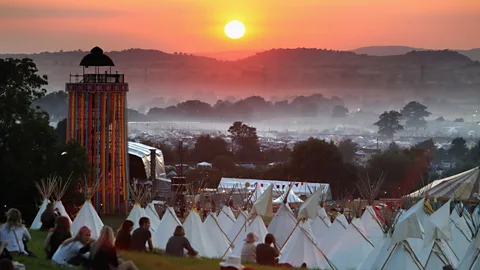 Getty Images
Getty ImagesSummer solstice is when folk fans – of all generations – come out in force. But is the new folk movement taking over from a culture traditionally dominated by boomers, asks Matilda Welin.
Glastonbury's Avalon tent, late afternoon, the summer of 2022. On stage: Kate Rusby, one of Britain's biggest folk musicians, ending her performance with folk classic Wild Mountain Thyme, the whole tent singing along. More and more people arrive. Soon, the area reaches fever pitch and the entrances to the field have to be closed. The next act up? British pop band McFly.
More like this:
Folk music in Britain is changing. The old guard, people playing the fiddle and banjo, singing mournful songs about fair maidens, might be diminishing in numbers but their music is not dying – it's blossoming. At Glastonbury, folk musicians share a stage with the Sugababes. At folk music festivals like Skye Live and Fire in the Mountain, they inspire young audience members to form mosh pits, usually associated with pop and rock.
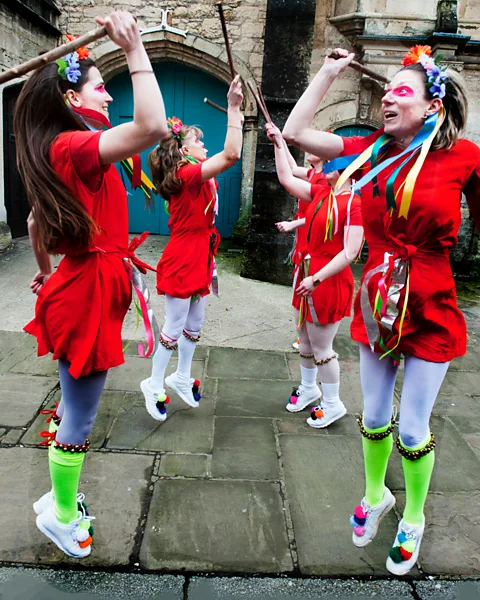 Getty Images
Getty ImagesMuch of this happens in the warmer months. Themes of youth, summer and nature are tightly woven through folk culture. Songs tell stories of young couples meeting in meadows, and of the magic light of short-houred nights, and the summer solstice is of particular importance in folk culture. Folk outfits and folk instruments are often made from natural materials such as wood or bone. Ari Aster's folklore-themed 2019 film Midsommar was set in June, and Shakespeare's A Midsummer Night's Dream is set in a folkloric, summertime dreamscape. As summer draws near, folk fans prepare for celebrations.
There's currently a "huge, huge enthusiasm" for new types of folk culture, according to ethnomusicology professor Fay Hield at the University of Sheffield. "In this kind of post-Brexit, Black Lives Matter narrative, people are wanting to engage in a kind of England or a kind of Englishness that they're proud of," she tells BBC Culture. "They are leapfrogging colonialism… but they still want to be proud of place. [It's more about] rituals... than the social history of England. Because that would be harder to navigate politically." And while this is not intrinsically linked to summer, Hield says, outdoor festivals certainly enable visitors to go to a place, both mentally and physically, where they can connect with their roots.
However, the folk music movement is quite insular. It has its own sound, nuances and traditions, like singarounds and sessions, and its own fans and musicians, often older and middle class. As part of a project researching folk singing in England, Hield and her colleagues have found that non-folkies can associate terms like "folk music" mainly with phrases like "beardy old man" or "white man with guitar". (Although also, when asked for an association with the word "folklore", the response "Taylor Swift" was frequently given – perhaps unsurprisingly since it was the name of the artist's 2020 album). The team's research also suggests that young people are put off by the lack of a broad representation of different ages, races, genders and sexualities in the folk world, both in the audiences and in the song texts themselves – and that other music scenes seem to have achieved a greater degree of racial inclusivity than folk. "Diversity is a huge issue," Hield says, "mostly because people only get into the folk scene if they already know somebody in it."
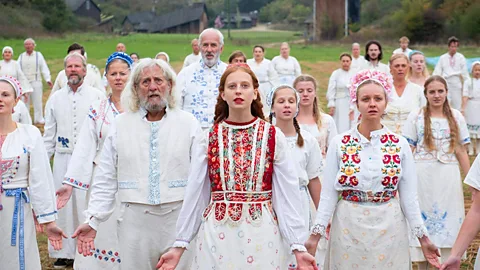 Alamy
AlamyAs a result, the new, more diverse, wave of folk has taken its expression outside the established venues. "The thing that has really grown is enthusiasm and desire," says Hield, "rather than actual participation in stuff that is already available. Even though [new people] may be interested in a similar repertoire [as the old guard], they're approaching it in different ways. And sometimes that rubs people up the wrong way." Even though new groups like the Shovel Dance Collective and the Longest Johns sound folky, Hield says, there is something contemporary about their sound. And performance troupes such as Boss Morris look and feel current. "The Boss Morris costumes reference the traditional [Morris dancing] teams, but they're not the same," says Hield. "They're very Instagrammable, very crafts movement. The group does things like dancing with Wet Leg at the Brits, or having big owl puppets; more contemporary aesthetics." The songs, music and dance also often serve as vehicles for other kinds of connection, Hield suggests, to midsummer, Pagan festivals and ceremony.
Established folk musicians frequently call for more young people to join their gatherings. The old guard is dying; there is a need for new blood. "But whatever people are trying, it doesn't seem to work," says Hield. "There is a huge folk festival network, which the existing folkies frequent, but younger people are less likely to go to them. Even though they might go to the Glastonbury's Avalon stage, they might not go to a local folk festival down the road." For newbies to be interested, she suggests, existing offerings might need to change.
ShantyTok and New Folk
During the pandemic, Johnny Stewart, a classical and acapella bass singer based in London, missed singing with others. Turning to TikTok, he discovered that the platform allows anyone to add content to other people's videos, encouraging musical collaboration. When Scotsman Nathan Evans's version of old New Zealand sea shanty the Wellerman became big in 2021, TikTok creativity blossomed. "People started adding violin, high female vocals, dancing and other things [to the song]," Stewart says. "It was a whole chain." After adding a bassline to one chain of harmonies, Stewart saw his video getting a life of its own as it spread across the web. "It wasn't planned," he says. "If you tried to recreate it from scratch, you couldn't."
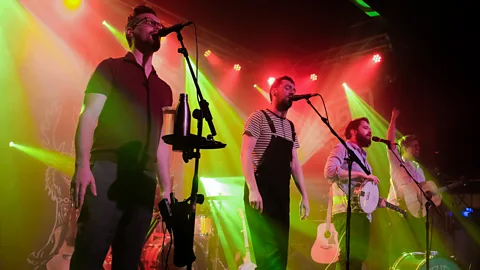 Getty Images
Getty ImagesNow, Stewart and some of the other singers from the video chain have released a record. Calling themselves the Wellermen, they have become known almost entirely through social media, which is now a major conduit for folk fandom. So-called reaction videos for example, viewed tens of thousands of times, show people listening to the deep, bassy resonance of the group's version of the song Misty Mountains (from the Lord of the Rings soundtrack).
Today, Wellermen fans range from those who enjoyed the "ShantyTok" trend in 2021, and then went back to their lives, to those who discovered folk and have remained fans of the genre, to old folkies who have come across the group via a video or a Spotify recommendation. "It means a lot when folkies say they like us," says Stewart. "It would be easy for them to say that we haven't put the yards in. But we have not experienced any gatekeeping." Traditional folk artists have also started turning to "Instagram and the other apps" themselves, Stewart says. "The best way to get younger audiences," he says, "is to reach them where they consume music. For that, TikTok is a blessing."
Hield, too, sees bridges being built between different folk fans. In some ways, she says, the new generation is just revisiting modern folk music's 1960s movement; just like the new wave, the 60s and 70s scene was very visual, and quite political as well. And there is another link to those days: while most pop music fans don't personally own a drum kit, members of the old folk guard almost always play folk music themselves. Perhaps partly thanks to the genre's alternative, self-made image, the border between music producer and music consumer is porous. While traditional music in the 80s and 90s had a listenership but less participation, Hield says, the new folk wave has returned to the old custom: they actually make music.
Band The Longest Johns did some big online singalong projects during the pandemic, inviting their audience to participate with them. And while the sound of folk artists since the 1980s like Kate Rusby, Seth Lakeman and more recently The Unthanks is quite highly produced, the music of new acts – such as the Shovel Dance Collective and social-media sea shanty singers – is grittier and rougher. Anybody can take part. "The whole Wellerman thing made folk fashionable," says Hield. "Groups like Boss Morris have been invited to folk festivals, and are now dancing in the same places as the old guard. So those relationships are developing."
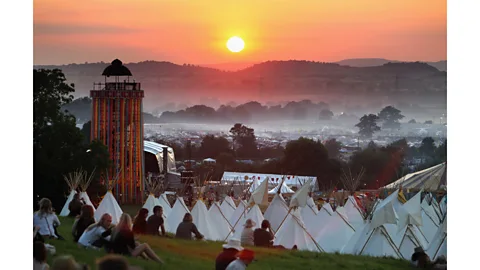 Getty Images
Getty ImagesGlastonbury's Avalon artists programmer Eddie Barcan would not describe his section of Glastonbury as a folk festival, he tells BBC Culture. In fact, when Glasto festival co-founder Michael Eavis first asked him to join the team, and to recreate previous work he had done at the Cambridge Folk Festival, Barcan had to caveat his answer. "I said, 'Well, no, I don't think it would work. But I can do something that would be appropriate for a Glastonbury audience'," he recalls.
In fostering a tradition, he says, different people have different roles; some preserve things and some broaden the horizon – and his job is the latter. "Traditionalists may view people who are less purist as a threat, but battles about subgenres and what is and isn't folk is a bit of waste of time, really," Barcan says. "If it wasn't for people teaching traditional styles, that couldn't continue and survive. But if it wasn't for people reaching wider audiences, there would be no one to listen."
And if you liked this story, sign up for the weekly bbc.com features newsletter, called The Essential List. A handpicked selection of stories from BBC Future, Culture, Worklife and Travel, delivered to your inbox every Friday.
